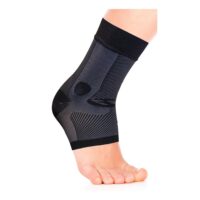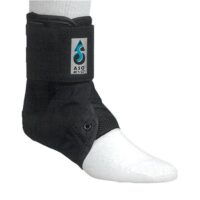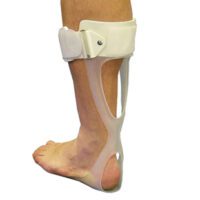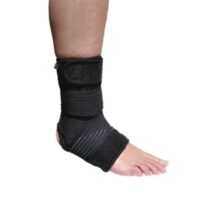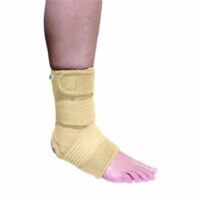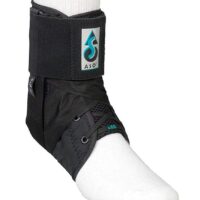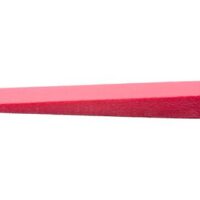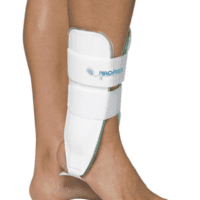Ankle Fracture
Article by John Miller

Treating an Ankle Fracture
An ankle fracture, commonly referred to as a broken ankle, involves a break in one or more of the ankle bones: the tibia, fibula, or talus. Such fractures range from simple cracks to complex breaks affecting stability and function.
The Treatment Journey for a Broken Ankle
Physiotherapy plays a pivotal role in the recovery from an ankle fracture. Treatment begins with an accurate assessment to determine fracture type and stability, guiding the choice between non-surgical and surgical treatment paths.
Surgical Approach
Unstable fractures typically necessitate surgical intervention, usually through Open Reduction with Internal Fixation (ORIF). This procedure involves the use of metal plates and screws to realign and stabilise the bones. Post-surgery, the journey to regain your mobility begins earnestly with physiotherapy.
Non-Surgical Management
Stable fractures may heal with conservative treatments like splinting or a moon boot, which protect and support the ankle. Monitoring by a healthcare professional is essential to ensure the fracture heals correctly.

Physiotherapy: The Backbone of Recovery
After an ankle fracture, physiotherapy is crucial, starting with gentle movements soon after surgery to prevent stiffness. As healing progresses, physiotherapists guide patients through stages designed to restore joint range, muscle strength, and balance.
Early Phase of Physiotherapy
In the initial weeks, physiotherapy focuses on controlling swelling, managing pain, and beginning gentle movements within the limits of a protective boot. The goal is to maintain as much movement and muscle activity as possible without compromising the healing process.
Progressive Weight-Bearing
This gradual reintroduction of weight-bearing activities helps in reconditioning the muscles and bones to bear the body’s weight again. Typically, patients start weight-bearing exercises under professional supervision of their physiotherapist.
Advanced Physiotherapy Techniques
As healing advances, physiotherapy becomes more dynamic. Exercise regimens become more rigorous, aiming to restore proprioception—a sense of joint position—which is crucial for balance and coordinated movements.
Restoring Functionality
When patients often transition to regular shoes and begin more strenuous physiotherapy to rebuild endurance and strength. At this stage, the focus shifts to regaining pre-fracture levels of activity.
Guided Return to Activities
Physiotherapy aims to safely return patients to higher-impact activities like running. However, such activities should only commence under a physiotherapist’s guidance after achieving specific milestones, such as a single-leg calf raise.
Customised Rehabilitation Plans
It’s worth noting that physiotherapy after an ankle fracture is not a one-size-fits-all approach. Programs are tailored to individual needs, and adherence to the prescribed plan is key to a successful recovery.
Supportive Devices and Ongoing Care
Throughout recovery, patients might use supportive devices such as a walking boot. Following the specific weight-bearing advice of your physiotherapist is paramount for a safe and effective return to full mobility.
Healing Timeframe
While general guidelines suggest a minimum of six weeks for bone remodelling, full recovery, especially for those requiring full weight-bearing, may take 12 weeks or longer. Adherence to physiotherapy instructions significantly impacts the speed and extent of recovery.
The Crucial Role of Patient Compliance
It’s vital for patients to understand that recovery from an ankle fracture is an active process. Compliance with all medical and physiotherapy instructions enhances the healing process and helps prevent complications like tibiotalar joint arthritis.
Conclusion
Physiotherapy treatment is a cornerstone in the recovery from an ankle fracture, ensuring that patients not only heal but also regain their full range of motion and strength. While the journey from a broken ankle to full recovery can be long, especially after surgery, the adherence to a personalised physiotherapy plan lays the foundation for a return to normal activities, offering a light at the end of the tunnel for those affected by this common but challenging injury.
Rochedale - Call 38410277
Book Online: RochedaleSalisbury - Call 32751044
Book Online: SalisburySandgate - Call 32691122
Book Online: SandgateCommon Causes of Ankle Pain
Introduction
Welcome to our detailed guide on the common causes of ankle pain. As physiotherapists, we understand how various conditions and injuries can lead to discomfort in your ankle. From sprains to degenerative diseases, this guide aims to provide clear insights for the general public on navigating these issues.


Sprained Ankles and Syndesmosis Injuries
Sprained ankles, including syndesmosis injuries, are among the most common issues we encounter. These injuries can range from mild ligament stretches to severe tears, impacting your mobility and quality of life. Understanding the specifics of each type is crucial for effective treatment and timely recovery.
Ankle Tendinopathies
Tendinopathies, such as those affecting the Achilles and tibialis posterior tendons, are common in active individuals. These conditions arise due to overuse or trauma, leading to pain and swelling in the affected area. Targeted physiotherapy can significantly aid in recovery and prevent future injuries.
Posterior Ankle Conditions
Conditions like posterior ankle impingement and retrocalcaneal bursitis can cause significant pain, especially during physical activities. Recognising these conditions early and starting appropriate treatment is vital for maintaining ankle health and functionality.
Ankle Arthritis
Arthritis in the ankle, often a result of wear and tear or injury, leads to joint pain and stiffness. Early intervention and proper management, including physiotherapy, are essential to slow its progression and manage symptoms effectively.
Biomechanical Conditions
Abnormal foot and ankle biomechanics can lead to various issues, from pain during weight-bearing to nerve compression. Understanding and treating these conditions are crucial for restoring normal function and preventing further complications.
Systemic Conditions That May Cause Ankle Pain
Systemic diseases such as rheumatoid arthritis can manifest as ankle pain. It's important to address these underlying conditions to effectively manage ankle symptoms.
Conclusion
Ankle pain can arise from a multitude of causes, each requiring a unique approach to treatment. If you're experiencing ankle discomfort, we recommend consulting a physiotherapist or doctor for a thorough evaluation. A personalised care plan can significantly improve your quality of life and mobility.
Related Articles
- Sprained Ankle Treatment & Recovery Guide - This article provides comprehensive information on managing pain and inflammation for a sprained ankle, including initial RICE steps and exercises for restoring mobility.
- Anterior Ankle Impingement: Causes, Treatments, Tips & Guide - Offers insights into the causes of anterior ankle impingement, its treatments, and practical tips for management.
- Posterior Ankle Impingement: Causes & Treatments - Explains the condition of posterior ankle impingement, its causes, and available treatment options.
- Tibialis Posterior Tendinopathy - Discusses the condition affecting the tibialis posterior tendon, symptoms, and implications for foot arch pain and ankle stability.
- Achilles Tendinopathy - Answers frequently asked questions about foot and ankle pain associated with Achilles tendinopathy and provides an overview of tendon injuries.
- How To Strap An Ankle - Guides on the correct techniques and types of tape for ankle strapping to prevent or manage ankle injuries.
Rochedale - Call 38410277
Book Online: RochedaleSalisbury - Call 32751044
Book Online: SalisburySandgate - Call 32691122
Book Online: SandgateFoot, Ankle & Heel Pain FAQs
Introduction
Welcome to PhysioWorks' comprehensive FAQ page on Foot, Ankle, and Heel Pain. Our expert physiotherapists are here to guide you in managing and overcoming discomfort. We’ve organised the FAQs into categories, each with a brief overview and links to in-depth articles, making navigation and understanding easier for you.


Foot Pain
Step into the various causes of foot pain and learn effective ways to relieve discomfort. Understand the impact of activities like barefoot running.
Ankle Injuries
Explore common ankle injuries and how to address them. From sprains to ligament damage, find out the best practices for care and prevention.
Heel Pain
Uncover the reasons behind heel pain and the effective treatments available. This section is particularly useful for understanding conditions like plantar fasciitis and heel spurs.
Achilles Pain
Find out how to manage and treat Achilles tendinopathy, a common concern for athletes and active individuals.
Shin Pain
Learn about shin splints, their causes, and how to alleviate this common issue, especially among runners.
Youth Injuries
Gain insights into youth leg injuries, including growing pains and heel issues in children.
Balance & Proprioception
Enhance your balance and proprioception with our professional advice and exercises.
Rochedale - Call 38410277
Book Online: RochedaleSalisbury - Call 32751044
Book Online: SalisburySandgate - Call 32691122
Book Online: SandgateRelated Articles
- Sprained Ankle Treatment & Recovery Guide: Offers detailed advice on how to manage sprained ankles, including immediate recovery steps and physiotherapy treatments.
- Ankle Pain: Effective Management And Treatment Options: Discusses various conditions leading to ankle pain and outlines effective treatment strategies, highlighting the role of physiotherapy in pain reduction and mobility improvement.
- Plantar Fasciitis: Provides an overview of plantar fasciitis, including common causes, treatment options, and related conditions like peroneal tendinopathy and Achilles tendinopathy.
- Achilles Tendinopathy: Focuses on the causes of Achilles tendinopathy, its impact on heel pain, and a range of treatment and prevention strategies.
- Ankle Strapping: Complete Guide To Injury Prevention: Explains the benefits of ankle strapping as a preventative measure against injuries, with a focus on techniques and materials.
- Heel Pain: Explores various causes of heel pain, including tendon injuries, foot injuries, bone injuries, and systemic conditions, alongside recommended treatments.






